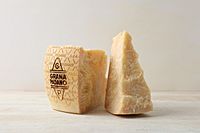Grana Padano facts for kids
Quick facts for kids Grana Padano |
|
|---|---|
 |
|
| Country of origin | Italy |
| Region, town | Emilia-Romagna: province of Piacenza Lombardy: Trentino-Alto Adige: Veneto: In addition to these main centres |
| Source of milk | Cows |
| Pasteurised | No |
| Texture | Hard |
| Aging time | 8–20 months |
| Certification | Italy: DOC 1955 EU: PDO 1996 |
Grana Padano is a type of cheese from northern Italy. It comes from the Po Valley and is a bit like Parmigiano Reggiano. It's made with slightly different rules than Parmigiano Reggiano. This cheese is hard and has a crumbly feel. It's made from cow's milk that hasn't been pasteurized and has had some cream removed naturally. To make sure it's always made the right way, Grana Padano has special protection. It's known as a protected designation of origin (PDO) in the European Union since 1996. This means only cheese made in certain areas of Italy, following strict rules, can be called Grana Padano.
Contents
What's in the Name?
The name "Grana Padano" tells you two things about the cheese. The word grana means "grain" in Italian. This refers to the cheese's special grainy texture. The word padano means "from the Val Padana", which is another name for the Po Valley. So, it's a "grainy cheese from the Po Valley"!
A Bit of History
Grana Padano cheese was first made by monks in the Chiaravalle Abbey way back in the 12th century. That's over 800 years ago! The monks wanted a cheese that could last a long time without going bad. This cheese can be aged for up to two years. It's made in a similar way to Parmigiano Reggiano, but Grana Padano is produced in a much larger area of Italy.
How Grana Padano is Made
Grana Padano is a hard cheese that is cooked and then aged slowly. It needs to ripen for at least nine months. If a cheese wheel passes all its quality tests, it gets a special Grana Padano trademark burned onto it.
Here's how it's generally made:
- Cows are milked twice a day.
- The milk from the evening is skimmed to remove the cream.
- This skimmed milk is then mixed with fresh milk from the morning.
- The milk is put into large copper pots.
- It's heated, and a special ingredient is added to make the milk curdle.
- The curds are cut into tiny pieces, about the size of rice grains. This gives the cheese its unique grainy texture.
- The curds are then heated to about 53 to 56 degrees Celsius (127 to 133 degrees Fahrenheit).
- The cheese is made all year round.
- Younger Grana Padano cheeses are less crumbly and have a milder taste than older ones.
Around 150 factories in the Po Valley make Grana Padano. About 76,724 tons of this cheese are made each year!
What Grana Padano Looks Like
A whole wheel of Grana Padano is round, like a cylinder. It has flat tops and bottoms and slightly curved sides.
- It's usually about 35 to 45 centimeters (14 to 18 inches) across.
- It's about 15 to 18 centimeters (6 to 7 inches) tall.
- Each wheel weighs between 24 and 40 kilograms (53 to 88 pounds).
- The outside rind is thin and pale yellow.
Grana Padano is sold at different ages, which changes its taste and texture:
- "Grana Padano" (9 to 16 months old): This cheese is still a bit creamy, but you can start to feel its grainy texture.
- "Grana Padano oltre 16 mesi" (over 16 months old): This one is more crumbly and has a stronger taste.
- "Grana Padano Riserva" (over 20 months old): This is the oldest type. It's very grainy, crumbly, and has a rich, full flavor.
You might notice tiny, gritty spots in Grana Padano. These are called cheese crystals. They are made of an amino acid called tyrosine.
Good for You?
To make 100 grams (about 3.5 ounces) of Grana Padano, you need about 1.5 liters of milk. This cheese is packed with good things!
- It has many vitamins and minerals that your body can easily use.
- It's a good source of protein, including all nine essential amino acids your body needs.
- It's also easy to digest.
- Because of how it's made and aged, Grana Padano is naturally lactose-free. This means people who have trouble with lactose can usually eat it. It also has less fat than some other cheeses.
A 100-gram serving of Grana Padano cheese has about 398 calories.
Images for kids
See also
 In Spanish: Grana Padano para niños
In Spanish: Grana Padano para niños


